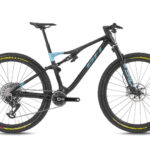For cycling enthusiasts who need to transport their bikes without sacrificing trunk space or vehicle flexibility, a Bike Carrier For Roof presents an excellent solution. Especially convenient for vehicles with lower roof heights, these carriers eliminate the struggle of high lifting and are broadly compatible with most cars equipped with a roof rack system. If you’re looking to bypass the cost and complexity of towbar or hitch installations, a rooftop bike carrier is definitely worth considering.
Exploring Different Types of Bike Carriers for Roof
When it comes to selecting a bike carrier for roof, you’ll encounter three primary designs, each with distinct advantages tailored to different bikes and user preferences: fork-mounted, wheel-mounted, and frame-mounted carriers.
Fork-Mounted Bike Carriers
Fork-mounted bike carriers require the removal of your bicycle’s front wheel for attachment. By securing the bike by its front fork to the carrier, they offer exceptional stability during transit. These are particularly well-suited for road bikes and bicycles equipped with quick-release wheels, providing a secure and aerodynamic transport method. They are a favorite among serious cyclists due to their robust hold and minimal bike movement at higher speeds.
Wheel-Mounted Bike Carriers
Opting for a wheel-mounted bike carrier means you can keep both wheels on your bike during transport. This design significantly speeds up the loading and unloading process, making it incredibly convenient for cyclists who frequently use their carriers. Wheel-mounted options are versatile and can accommodate a wide range of bike styles, from mountain bikes to hybrid models, making them a practical choice for regular bike transportation.
Frame-Mounted Bike Carriers
Frame-mounted bike carriers offer a versatile approach by securing the bicycle by its frame. This type of carrier is adaptable to various bike sizes and frame geometries, including mountain bikes, women’s bikes, and bikes with unique frame designs that might not fit fork or wheel mounts easily. Frame-mounted carriers are a robust and reliable option for transporting diverse types of bicycles securely on your vehicle’s roof.
Advantages of Using a Bike Carrier for Roof
Choosing a bike carrier for roof comes with a range of benefits, making them a popular choice for cyclists seeking practicality and convenience:
- Unobstructed Rear Vehicle Access: One of the most significant advantages is maintaining complete access to your vehicle’s trunk or rear cargo area. With bikes positioned on the roof, loading groceries, luggage, or any gear into the back of your car remains hassle-free, perfect for trips and daily errands alike.
- Multi-Purpose Functionality: Roof-mounted systems aren’t limited to just bikes. Many roof racks are designed to be adaptable, allowing you to transport other outdoor equipment such as kayaks, canoes, skis, snowboards, and even cargo boxes. This versatility makes a roof carrier system a valuable investment for various recreational activities.
- Enhanced Stability During Transport: Bike carriers for roof are engineered to provide a stable and secure platform for your bicycle. This robust mounting minimizes bike sway and movement during travel, significantly reducing the potential for damage from vibrations, wind resistance, or accidental bumps along the road.
- Integrated Security Features: Many modern bike carrier for roof models come equipped with built-in locking mechanisms. These systems secure both the bike to the carrier and the carrier itself to your vehicle’s roof rack, providing added security and deterring theft when you need to leave your car unattended. This offers peace of mind, especially during stops on longer journeys.
Key Considerations When Selecting a Bike Carrier for Roof
Before you decide on a bike carrier for roof, there are several important factors to take into account to ensure the best choice for your vehicle and cycling needs:
- Vehicle Height and Lifting Capability: Assess the height of your vehicle and your personal ability to lift your bike onto the roof. Consider that lifting a bike overhead to secure it on the carrier will be a regular task. If you have a taller vehicle or find it physically challenging to lift heavy items overhead, this might be a significant consideration.
- Clearance Limitations: Be mindful of overhead clearances, especially in areas with low height restrictions such as garages, parking garages, or tunnels. Forgetting about your roof-mounted bike when entering such areas can lead to damage to both your bike and your vehicle. Always double-check your clearance height with bikes loaded.
- Roof Weight Capacity: Consult your vehicle’s manual to confirm the maximum weight capacity of your roof rack system. Ensure that the combined weight of the bike carrier for roof and your bicycle(s) does not exceed this limit. Overloading can compromise safety and potentially damage your vehicle’s roof.
- E-bike Compatibility: If you own an electric bike, remember that e-bikes are typically heavier than traditional bicycles. Verify that the bike carrier for roof you are considering is specifically rated to handle the weight of your e-bike. Also, the increased weight of e-bikes can make lifting them onto a roof carrier more challenging, so consider the ease of loading and unloading.
Explore our extensive selection of bike carriers for roof to find the ideal solution for your cycling adventures. Whether you are a road biking enthusiast, a mountain trail explorer, or a casual cyclist, we offer a range of fork-mounted, wheel-mounted, and frame-mounted options to securely and conveniently transport your bike.
For more detailed guidance on selecting the perfect bike rack, refer to our comprehensive guide on choosing the best bike rack for your car. Browse our complete collection of roof bike racks today to discover the perfect match for your vehicle and elevate your biking experiences.

